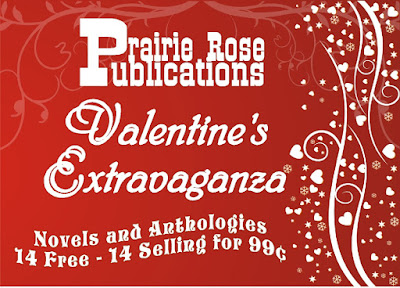Has everyone had a good week? Hope so! We sure have. There's a lot of truth in the old saying "it's better to give than receive." We at Prairie Rose Publications have enjoyed giving y'all some great reading for free this week.
Free! You can't beat that with a stick.
We're almost out of time, though. If you haven't moseyed on over to Amazon to pick up your free and 99-cent books yet, you might want to get a hustle on. Today's the last day! You can find a list of all the books, with links,
here. Links to all the books also appear at the bottom of this post.
I thought I'd throw some value-priced boxed sets in your path so you could stumble over them while you're over yonder picking up freebies. (I have an evil streak.) Boxed sets are a great deal: You get multiple stories by multiple authors, and all of them are first-rate. I don't know about anyone else, but I find a new favorite author every time I pick up a boxed set. My budget hates it when that happens.
All of these boxed sets are only 99 cents — or free if you're a Kindle Unlimited subscriber.
A Kiss to Remember: Get ready for some wonderful hours of pleasure-filled reading as you settle back in your easy chair and get lost in five full-length stories by five award-winning and best-selling authors. In
Her Sanctuary by Tracy Garrett, a preacher falls in love with a grieving young woman, only to discover she harbors a secret that may tear them apart. A gunman and a woman from his past face treachery in an unforgiving town in Cheryl Pierson's
Gabriel's Law. The outlaw in Tanya Hanson's
Outlaw Heart finds going straight would be a whole lot easier if an angel didn't keep tempting him.
The Dumont Way by Kathleen Rice Adams contains a trilogy of Civil War-era novellas that prove the love of a good woman can save a man's tortured soul. In
Yesterday's Flame by Livia J. Washburn, a pair of firefighters from different centuries fall in love amid the chaos of the Great San Francisco fire.
A Cowboy's Touch can heal anything — including lost love, hard times, and angry moments. In these four full-length novels, emotion runs high with the tingle of danger and the heat of love:
The Half-Breed's Woman by Cheryl Pierson,
Prodigal Gun by Kathleen Rice Adams,
Spirit Catcher by Livia J. Washburn, and
Wild Texas Winds by Kit Prate.
Hold on to your Stetson and get ready for some darn fine reading.
A Cowboy's Heart contains five full-length western romance novels offering hours of reading pleasure with something for everyone:
Time Plains Drifter by Cheryl Pierson,
Claiming His Heart by Tanya Hanson,
The Calling by Sara Barnard,
Saint or Sinner by Gil McDonald, and
All for Love by Beverly Wells.
 A Cowboy's Brand
A Cowboy's Brand is a sensational boxed set guaranteed to make you smile. This collection includes five full-length novels from some of the best western romance writers writing today:
Across the Sweet Grass Hills by Gail L. Jenner,
Harmonica Joe's Reluctant Bride by Sarah J. McNeal,
Into the Land of Shadows by Kristy McCaffrey,
Double Crossing by Meg Mims, and
Mending Fences by Livia J. Washburn.
Love's First Touch is powerful and sweet. It can move the heart to realize the true depth of emotion that only a first love can bring. There’s some exciting reading ahead in these five full-length novels! Come join these wonderful characters as they experience awakening feelings and tumultuous relationships that can only be discovered with
Love's First Touch:
Digging Holes in Paradise by Karen Mihaljevich,
Drina's Choice by Agnes Alexander,
Double or Nothing by Meg Mims,
Fly Away Heart by Sarah J. McNeal, and
Wish for the Moon by Celia Yeary.
There's something for everyone in
Love, Come to Me, a wonderful collection of love stories from different time periods. We challenge you to stop reading in the middle of any of them. Each story is heart-warming in its own way, guaranteed to have you falling in love with the characters and the stories of their lives. Take a look:
The Violin by Sarah J. McNeal,
Family Secrets by Zina Abbott,
Who is Elizabeth? by Patti Boeckman,
Shattered Vows by Linda LaRoque, and
Kissing Cousins by Diana Tobin.
From the
Home Fires of the Civil War to a hard-won
Race to Marry, you’ll love these tales of feisty ladies and
Six Sizzlin' Mavericks who know how to live and love to the fullest. The collection contains two Christmas tales,
Christmas Stroll and
Hearts in Winter, which are sure to keep you wishing for a Wyoming snowfall and an old-time, full-blown holiday of your very own.
The Widow's Lawman and
The Ballad of Annie Sullivan round out this boxed set with a couple of tales that will keep you on the edge of your seat until the very last page.
Are you ready to ride into the old west with six fantastic tales of outlaws, lawmen, Apaches, and ex-gunmen? There's nothing like outwitting a band of Apache warriors, facing down a man with a hard grudge, or standing with a brother you don't agree with and doing it all from your easy chair. Each and every one of these tales of the west are guaranteed to keep you turning pages. You'll share these hard-hitting action adventures as surely as if you were standing in the dusty Texas heat or the wilds of Indian Territory alongside the outlaws, marshals, and bounty hunters captured in the pages of
Code of the West. So, DRAW...if you dare!
I promised y'all the links to all the special deals, so here they are! Just remember: You've only got today to take advantage of the offer. Light a shuck!
Free Feb. 13-17
99 Cents


















